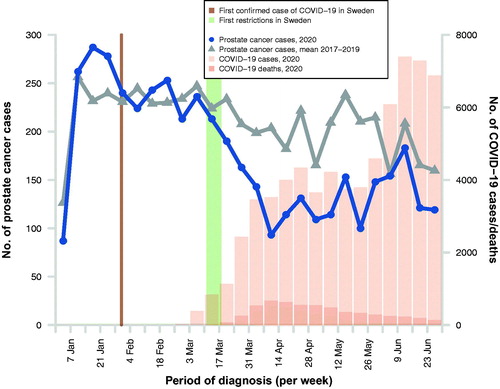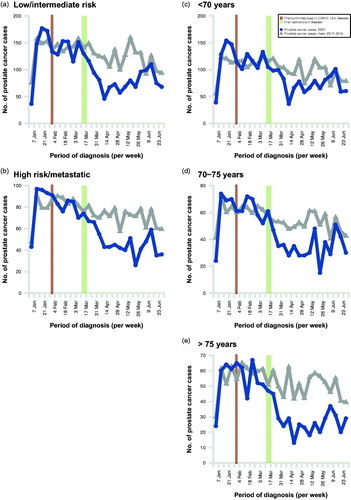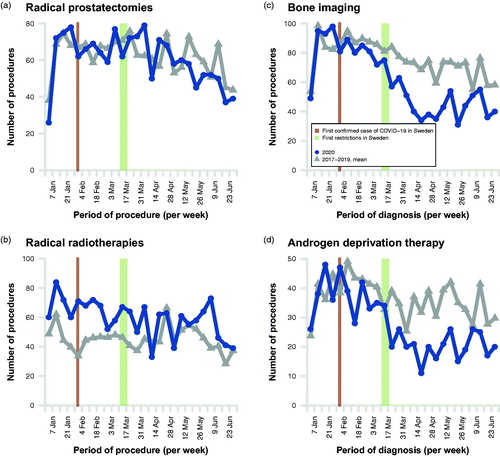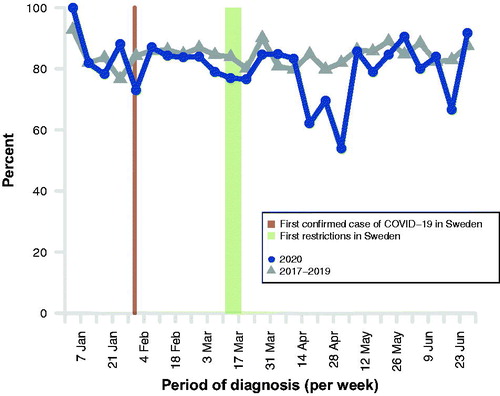Abstract
Introduction
The first case of COVID-19 in Sweden was diagnosed in late January 2020, the first recommendations against the spread of the virus were released in mid-March, and the peak of the first wave of the pandemic was reached in March-June. The aim of this cross-sectional study was to assess the short-term effects of the first wave of the COVID-19 pandemic on prostate cancer (PCa) diagnosis, staging, and treatment.
Materials and methods
Data in the National Prostate Cancer Register (NPCR) of Sweden on newly diagnosed PCa cases and on the number of diagnostic and therapeutic procedures performed between 18 March 2020 and 2 June 2020 were compared with those in the corresponding time periods in 2017–2019, as reported until January 31 of the year after each study period.
Results
During the study period in 2020, 36% fewer PCa cases were registered in NPCR compared with the corresponding time period in previous years: 1458 cases in 2020 vs a mean of 2285 cases in 2017–2019. The decrease in new PCa registrations was more pronounced in men above age 75 years, down 51%, than in men aged 70–75, down 37%, and in men below age 70, down 28%. There was no decrease in the number of radical prostatectomies and number of radical radiotherapy courses increased by 32%.
Conclusions
During the peak of the first phase of the COVID-19 pandemic, the number of men diagnosed with PCa in Sweden decreased by one third compared with previous years, whereas there was no decrease in the number of curative treatments.
Introduction
A number of recommendations aimed to reduce the transmission of COVID-19 was issued by the Swedish Public Health Agency in mid-March 2020 [Citation1]. While these recommendations were less strict than in many other countries, they included advice on strict hand hygiene, social distancing, no gatherings of more than 500 people (subsequently reduced to 50 people), remote e-teaching in high school and universities, work from home whenever possible, discouraging international and domestic travel, no visits to nursing homes, and strong advice to stay at home in case of respiratory symptoms or fever. However, there were no regional or national formally imposed lockdowns, no mandated quarantine for COVID-19 positive individuals, and no recommendation of wearing facemasks [Citation1]. Overall, almost 90% of Swedish citizen reported to have changed their habits due to the pandemic [Citation2]. In January 2021, almost 12,000 COVID-19 related deaths had been registered in Sweden, according to the World Health Organization. In the neighbouring Scandinavian countries, each with a population of half that of Sweden, substantially fewer deaths were attributed to COVID-19 during the same time period: 2100 in Denmark, 500 in Norway, and 700 in Finland [Citation3].
The Swedish health care system was strongly affected by the pandemic. Specific COVID-19 departments were created with staff from various disciplines, including urology, and the intensive care capacity in Sweden doubled from around 500 available beds before the pandemic to over 1,000 beds at the height of the first wave of the pandemic [Citation1].
The European Association of Urology (EAU) issued recommendations for urological care during the pandemic. Work-up for men with moderately raised PSA values and treatment of men with low and intermediate-risk PCa was recommended to be postponed since these cancers are unlikely to cause harm in short-term [Citation4–7].
In Sweden, the national PCa guideline group, as well as the regional guideline groups in the health care regions West and Stockholm, also issued recommendations that included to avoid PSA testing of asymptomatic men, to transfer outpatient clinics to remote consultations (e.g. phone calls or digital meetings), and to postpone non-urgent PCa treatment for men above 70 years and for men with pulmonary or cardiac comorbidities [Citation8].
The impact of the pandemic and its downstream effects on cancer services on a national level is largely unknown. The aim of this cross-sectional study was to assess the short-term impact of the COVID-19 pandemic on prostate cancer (PCa) diagnosis, staging, and treatment.
Material and methods
The National Prostate Cancer Register (NPCR) of Sweden
NPCR captures 98% of all new PCa cases registered in the Swedish Cancer Registry to which reporting is mandated by law [Citation9–11]. About half of new PCa cases are registered in NPCR within 3 months after the date of diagnosis, 80% within 6 months, and 95% within 9 months (Supplementary Figure 1) [Citation12].
Study population and design
In this cross-sectional study, we compared the number of PCa cases registered in NPCR with date of diagnosis from 18 March 2020, when the first recommendations were issued, to 2 June 2020, when the number of deaths form COVID-19 decreased steeply, with the mean of the corresponding number of cases diagnosed in the same time periods in 2017–2019 and reported before January 31 of the year after each study period. We also compared the number of diagnostic and therapeutic procedures during the same time periods. Aggregated data on the number of COVID-19 cases and COVID-19 deaths were retrieved from The Swedish Public Health Authority (Folkhälsomyndigheten) website [Citation13]. Analyses were performed in December 2020.
Variables
PCa risk categories were defined as low/intermediate-risk = clinical local stage T1-2, Gleason score 6–7 and/or PSA ≤20 ng/ml, or high-risk/metastatic = clinical T-stage ≥ T3 and/or Gleason score 8–10 and/or PSA >20 ng/ml and/or N1 and/or M1. We assessed the number of bone imaging procedures, including bone scintigraphy, CT, MRI, PET-CT, and plain X ray, as well as the number of radical prostatectomies (RP), radical radiotherapy courses (RRT), and the use of androgen deprivation therapy (ADT) as primary treatment for PCa, including GnRH agonists and antagonists, bicalutamide and bilateral orchiectomy, as registered in NPCR. The study was approved by the Swedish Research Ethics Authority.
Results
Number of new prostate cancer cases
During the period with the highest COVID-19 mortality between 18 March and 2 June 2020, 36% fewer men were diagnosed with PCa compared with the corresponding time period in the previous three years, 1458 vs mean 2285 (, ). While the number of confirmed COVID-19 cases increased steadily from March and onwards, mortality attributed to COVID-19 decreased after a peak in mid-April (Supplementary Table 1).
Figure 1. Number of cases of prostate cancer registered in the National Prostate Cancer Register (NPCR) of Sweden per week from 1 January to 30 June 2020, compared with the mean number in the same calender period in 2017–2019, as reported until January 31 of the year after each study period. #Data on number of COVID-19 cases and deaths from COVID-19 are taken from the Public Health Agency of Sweden (https//:www.folkhalsomyndigheten.se).

Table 1. Number of prostate cancer cases registered in The National Prostate Cancer Register (NPCR) of Sweden from March 18th to June 2nd in 2017–2020, reported until January 31st of the year after each study period.
Number of new prostate cancer cases by health care region
The number of COVID-19 cases and the number of deaths from COVID-19 were highest in the Stockholm-Gotland health care region, whereas the decrease in the number of PCa cases was more pronounced in the healthcare region West, down 48%, and in the Uppsala-Örebro health care region, down 39%, compared with a 23% decrease in Stockholm (, Supplementary Table 2).
Figure 2. Number of cases of prostate cancer registered in the National Prostate Cancer Register (NPCR) of Sweden per week from 1 January to 30 June 2020, compared with the mean number in the same calender period in 2017–2019, as reported until January 31 of the year after each study period. #Data on number of COVID-19 cases and deaths from COVID-19 are taken from the Public Health Agency of Sweden (https//:www.folkhalsomyndigheten.se). Aggregated COVID-19 data for the entire population were only available at health care region level. Part of region Halland belongs to health care region West and part belongs to health care region South, therefore data for Halland was included in both regions.

Number of new prostate cancer cases by age and risk category
The numbers of new low/intermediate-risk and high-risk/metastatic PCa were both lower in 2020 than 2017–2019 (, Supplementary Table 3). The number of men diagnosed with low/intermediate-risk PCa decreased by 40%, 846 in 2020 vs a mean of 1415 in 2017–2019. The number of men diagnosed with high-risk/metastatic PCa decreased by 36%, 519 in 2020 vs a mean of 805 in 2017–2019. No difference was found in the proportion of men with PSA over 100 ng/ml at diagnosis (data not shown).
Figure 3. Number of prostate cancer cases registered in the National Prostate Cancer Register per week according to prostate cancer risk category and age at diagnosis, from 1 January to 30 June 2020, compared with the mean number in 2017–2019, as reported until January 31 of the year after each study period. Prostate cancer risk categories: low/intermediate-risk: clinical local stage T1-2, Gleason score 2–7 and/or PSA 10 to ≤20 ng/ml; high-risk/metastatic: clinical T-stage ≥ pT3 and/or Gleason score 8–10 and/or PSA >20 ng/ml and/or N1 and/or M1

The decrease was more pronounced for men above age 75 than for men below 75 years. There was a 51% decrease of new PCa cases among men above 75 years, 281 in 2020 vs a mean of 572 in 2017–2019, a decrease of 37% among men aged 70–75, 368 in 2020 vs a mean of 588, in 2017–2019 and a decrease of 28% among men under 70 years, 809 in 2020 vs a mean of 1125 in 2017–2019.
Patterns of prostate cancer management: staging and treatment
During the study period the number of radical prostatectomies remained essentially unchanged, 1574 RPs in 2020 vs a mean of 1622 RPs in 2017–2019 (, Supplementary Table 4), but there was 32% increase in number of radical radiotherapy courses during the study period: 1547 RRTs in 2020 compared with a mean of 1176 in 2017–2019. The proportions of men with low/intermediate or high-risk/metastatic PCa who underwent RP or RRT remained unchanged, as was their age distribution (Supplementary Figure 2(a,b), Supplementary Table 5). Use of ADT as primary treatment for PCa was 25% lower in 2020 than in previous years: 709 vs 946 men in 2017–2019.
Figure 4. Number of radical prostatectomies, radical radiotherapy courses, bone imagining and start of androgen deprivation therapy as primary treatment per week registered in the National Prostate Cancer Register from 1 January to 30 June 2020, compared with the mean number in 2017–2019, as reported until January 31 of the year after each study period. Androgen deprivation therapy includes GnRH agonist or antagonist, bicalutamide and bilateral orchiectomy as reported in NPCR.

Fewer men underwent bone imaging in 2020 than in 2017–2019: 1570 vs 1979, a 21% reduction (). The proportion of men with high-risk PCa below age 80 who underwent bone imaging remained high: 78% in 2020 compared with 84% in 2017–2019 (, Supplementary Table 6).
Figure 5. Percent of men below age 80 years with high-risk prostate cancer who underwent bone imaging per week registered in the National Prostate Cancer Register from 1 January to 30 June 2020, compared with the mean number in 2017–2019, as reported until January 31 of the year after each study period.

Discussion
In this population-based study, we found a 36% decrease in the number of men diagnosed with PCa in Sweden during the first wave of the COVID-19 pandemic. There was a slight decrease in the use of bone imaging and androgen deprivation therapy, whereas the number of radical prostatectomies remained unchanged and the number of radical radiotherapy courses increased.
The strengths of our study include the use of comprehensive data with cancer characteristics, diagnostic procedures, and primary treatment from a national clinical cancer register with a virtually complete capture nine months after the date of diagnosis. Nevertheless, it cannot be ruled out that the registration in the National Prostate Cancer Register of Sweden at some units was delayed during the pandemic, e.g. due to shortage of staff for entering data. However, by including cases registered through January of the year after the study period we optimized capture. The fact that the number of radical prostatectomies and radical radiotherapy courses were similar or higher than in previous years indicates that data were timely entered into the NPCR during the study period.
Our analysis cannot discern to what extent the decreased PCa incidence was caused by a reallocation of healthcare resources from that men refrained from PSA testing or seeking medical care for symptoms caused by PCa. The latter explanation is favored by that the number of referrals for a suspicion of PCa dropped during the pandemic, according to the separate registration of referrals for a suspicion of cancer (Swedish: standardiserat vårdförlopp, SVF) [Citation14].
The fact that the PCa incidence decreased most strongly in older men likely reflects the recommendation that people above age 70 should minimize social contacts, including non-urgent medical care, as they are at a higher risk of unfavorable outcomes of COVID-19 [Citation15].
The number of radical radiotherapy courses was, somewhat surprisingly, higher during the pandemic than in previous years, but this should be viewed in the light of an ongoing increase in use of radical radiotherapy in Sweden [Citation16]. As shown previously, the use of radical radiotherapy has increased substantially in Sweden after the publication of the SPCG-7 in 2009, in particular for men with locally advanced prostate cancer [Citation16,Citation17]. The number of radical prostatectomies remained the same as in previous years. These findings suggest that priority was put on treatment for cancer rather than for benign conditions.
Recent publications from Poland and Denmark have reported a 30% decrease in the number of referrals for all cancers during the first wave of the pandemic, which is in line with our observations [Citation18,Citation19]. A reduction of urological services has been reported [Citation20–22]. For example, a survey of European countries showed that clinical activities were affected in 54% of centres, and that 85% of elective surgeries were cancelled [Citation20]. Similarly, an international survey reported that 40% of referrals, 80% of biopsies and 70% of radical prostatectomies were postponed [Citation23]. In comparison to these reports, our study suggests that PCa services were less affected by the pandemic in Sweden than in many other countries.
To the best of our knowledge this is the first nationwide, population-based study on diagnosis, staging, and treatment of PCa during the COVID-19 pandemic with comprehensive data on cancer characteristics, staging, and treatment. Our results show that a clinical cancer register with a rapid capture of comprehensive data is a useful resource for surveillance of the consequences of a major disruption of health care. Of note, only the short-term consequences of the COVID-19 pandemic can be assessed at this time and it will take several years before the full effect of the pandemic on cancer care can be assessed.
Conclusions
In Sweden, a country with a high incidence of COVID-19 and with substantial reallocations of health care resources, the number of new PCa cases decreased by a third during the peak of the first wave of the pandemic, compared with the same time period in previous years. In contrast, the number of radical prostatectomy remained unchanged whereas the number of radical radiotherapies courses increased. Rapid registration in a clinical cancer register is essential for surveillance of major disruptions of cancer services, such as the one caused by a pandemic.
Supplemental Material
Download Zip (130 KB)Acknowledgments
This project was made possible by the continuous work of the National Prostate Cancer Register of Sweden (NPCR) steering group: Pär Stattin (chairman), Ingela Franck Lissbrant (co-chair), Camilla Thellenberg, Johan Styrke, Hampus Nugin, Eva Johansson, Lennart Åström, Magnus Törnblom, Stefan Carlsson, Marie Hjälm-Eriksson, David Robinson, Mats Andén, Ola Bratt, Olof Ståhl, Thomas Jiborn, Hans Joelsson, Gert Malmberg, Olof Akre, Johan Stranne, Jonas Hugosson, Maria Nyberg, Per Fransson, Fredrik Jäderling, Fredrik Sandin and Karin Hellström.
Disclosure statement
No potential conflict of interest was reported by the author(s).
Data availability statement
Data on an aggregated level can be made available on a remote server upon request to the corresponding author
Additional information
Funding
References
- Ludvigsson JF. The first eight months of Sweden’s COVID‐19 strategy and the key actions and actors that were involved. Acta Paediatr. 2020;109:2459–2471.
- TSCC Agency. Nästan hela befolkningen har ändrat sitt beteende med anledning av coronapandemin (Almost the entire population has changed its behavior due to the corona pandemic) [Internet]. Undefined. 2020 [cited 2020 Oct 5]. Available from: https://www.msb.se/sv/aktuellt/nyheter/2020/april/nastan-hela-befolkningen-har-andrat-sitt-beteende-med-anledning-av-coronapandemin/
- WHO. WHO Coronavirus Disease (COVID-19) Dashboard [Internet]. Undefined. [cited 2020 Oct 13]. Available from: https://covid19.who.int/
- Kutikov A, Weinberg DS, Edelman MJ, et al. A war on two fronts: cancer care in the time of COVID-19. Ann Intern Med. 2020;172:756–758.
- Ribal MJ, Cornford P, Briganti A, et al. EAU Section Offices and the EAU Guidelines Panels. European Association of Urology Guidelines Office Rapid Reaction Group: an organisation-wide collaborative effort to adapt the European Association of Urology Guidelines Recommendations to the Coronavirus Disease 2019 Era. Eur Urol. 2020;78:21–28.
- Carneiro A, Wroclawski ML, Nahar B, et al. Impact of the COVID-19 Pandemic on the Urologist’s clinical practice in Brazil: a management guideline proposal for low- and middle-income countries during the crisis period. Int Braz J Urol. 2020;46:501–510.
- Ficarra V, Novara G, Abrate A, et al. on behalf of Research Urology Network (RUN). Urology practice during the COVID-19 pandemic. Minerva Urol Nefrol. 2020;72:369–375.
- RCC. Nationellt vårdprogram prostatacancer – tillfälliga rekommendationer [Internet]. Undefined. [cited 2020 Oct 8]. Available from: https://www.cancercentrum.se/samverkan/covid-19/avvikelser-i-behandlingsrekommendationer/
- Hemelrijck MV, Wigertz A, Sandin F, et al. for NPCR and PCBaSe Sweden. Cohort profile: The National Prostate Cancer Register of Sweden and Prostate Cancer data Base Sweden 2.0. Int J Epidemiol. 2013;42:956–967.
- Cazzaniga W, Ventimiglia E, Alfano M, et al. Mini review on the use of clinical cancer registers for prostate cancer: the National Prostate Cancer Register (NPCR) of Sweden. Front Med. 2019;6:51.
- Barlow L, Westergren K, Holmberg L, et al. The completeness of the Swedish Cancer Register: a sample survey for year 1998. Acta Oncol. 2009;48:27–33.
- Tomic K, Berglund A, Robinson D, et al. Capture rate and representativity of The National Prostate Cancer Register of Sweden. Acta Oncol. 2015;54:158–163.
- Covid-19 [Internet]. Undefined. [cited 2020 Sep 10]. Available from: https://www.folkhalsomyndigheten.se/smittskydd-beredskap/utbrott/aktuella-utbrott/covid-19/
- Antal patienter i standardiserade vårdförlopp (SVF) – RCC [Internet]. Undefined. [cited 2020 Nov 2]. Available from: https://www.cancercentrum.se/samverkan/vara-uppdrag/statistik/svf-statistik/antal-patienter-i-svf/
- Zhou F, Yu T, Du R, et al. Clinical course and risk factors for mortality of adult inpatients with COVID-19 in Wuhan, China: a retrospective cohort study. Lancet. 2020;395:1054–1062.
- Orrason AW, Westerberg M, Garmo H, et al. Changes in treatment and mortality in men with locally advanced prostate cancer between 2000 and 2016: a nationwide, population‐based study in Sweden. BJU Int. 2020;126:142–151.
- Widmark A, Klepp O, Solberg A, et al. Endocrine treatment, with or without radiotherapy, in locally advanced prostate cancer (SPCG-7/SFUO-3): an open randomised phase III trial. Lancet. 2009;373:301–308.
- Maluchnik M, Podwójcic K, Więckowska B. Decreasing access to cancer diagnosis and treatment during the COVID-19 pandemic in Poland. Acta Oncol. 2020;60:28–31.
- Skovlund CW, Friis S, Dehlendorff C, et al. Hidden morbidities: drop in cancer diagnoses during the COVID-19 pandemic in Denmark. Acta Oncol. 2021;60:20–23.
- Heinze A, Umari P, Basulto-Martínez M, et al. Impact of COVID-19 on clinical and academic urological practice: a survey from European Association of Urology Section of Uro-technology. Eur Urol Open Sci. 2020;21:22–28.
- Paffenholz P, Peine A, Fischer N, et al. Impact of the COVID-19 Pandemic on Urologists in Germany. Eur Urol Focus. 2020;6:1111–1119.
- Wallis CJD, Novara G, Marandino L, et al. Risks from deferring treatment for genitourinary cancers: a collaborative review to aid triage and management during the COVID-19 pandemic. Eur Urol. 2020;78:29–42.
- Rosenzweig B, Bex A, Dotan ZA, et al. Trends in urologic oncology clinical practice and medical education under COVID-19 pandemic: an international survey of senior clinical and academic urologists. Urol Oncol. 2020;38:929.e1–929.e10.
